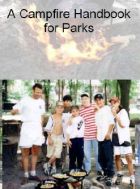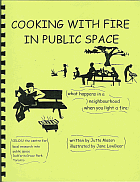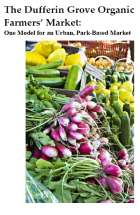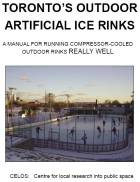

Pages in this Folder:

Related Folders:
See also Department Site Map
Support Provided by

Toronto Parks and Trees Foundation

This website has received support from celos.ca through the Trillium foundation.
Publications
Comments?
For the basics, see
- Website & Privacy Policies
- How To Get Involved
- The Role of the Park
Search options:
Department Site Map
Custodians:
1997
The field house:
Last summer and again this summer David Anderson’s Clay and Paper Theatre operated its summer youth theatre troupe (funded by the federal government’s ---program) using the field house as its workshop and base. That meant that the field house changed from being the hangout of the marijuana club to being the workplace of 6 (last year) and 10 (this year) young actors/ artists who made huge papier mache puppets and street-theatre sets and rehearsed there. They usually worked outside the field house under the linden tree, and all summer long people could stroll by and watch how street theatre is made. The company performed in various Toronto parks, including ours. This year they got a special grant from the Ontario Arts Council under a new heading “community theatre.” They put on a humorous play/ pageant about the building of our bake oven called “The Resurrection of Fornax,” which ran for four days at the end of August and had front-page coverage in the Toronto Sun’s Arts section. This production also involved some of the youth from the park basketball court, who were hired to help do the papier mache puppets and be part of the production crew. For the second year also Larry Lewis and Jane Low-Beer of the Crankee Consort (a local theatre company) had a grant from Theatre Ontario to do a ten-day youth theatre intensive at the park. Last year the production that resulted was called The Cod Project; this year it was The Graffiti Project. This year the company collaborated with David Anderson and did its public performance using the back wall of the field house as its giant graffiti backdrop. During the ten days the performers were rehearsing, the back part of the field house became another destination for people in the park to visit and watch. The production included music and soft electric guitar melodies drifted through the park on those days. A graffiti mural backdrop, which was done on a huge piece of fabric, is now stored in the rink house and available for other uses.
The Big Backyard:
Last summer at the Big Backyard the activities were tipi-building, occasional cooking fires, clay, and crafts and dress-up set out for drop-in play seven days a week. Steve Smith and Julie Whitfield of the Creative Environmental Education Project (check this) were running a small environmental arts camp at the Dufferin Mall, and they offered to come and do some workshops in the Big Backyard. Many children (and their parents) enjoyed these.
In September the Parks Department put in two water outlets for us at the north and south ends of the Big Backyard’s log enclosure. In October the first native shade garden beds were put in at the south border of the logs, with help from two grade five/six classes from Brock School. The plants were bought with a grant from Canada Trust’s Friends of the Environment Foundation and planted with the guidance of Gene Threndyle, a local artist/ gardener. In the spring the plants came up, including our first trilliums.
Because the environmental arts workshops had been so successful, this spring our group applied for and received some funds ($6000) from the City of Toronto’s Recreational Grants program, to offer the first Dufferin Grove Park Summer Environmental Arts Camp, run by Steve and Julie. With the help of another grant ($8000) from the city’s “Breaking the Cycle of Violence” program we were able to hire and supervise youth from the park and the neighbourhood to help staff this camp, which was fully booked all summer (twenty campers at a time; six separate one-week sessions). The camp also had ten drop-in spaces which were usually filled (or overfilled).
Isabel Perez came back to cook over the Big Backyard fire once a week. When local day camps discovered this, they scheduled park visits on those cooking-fire days. In that way a lot of children learned how to make donuts and dovladas (a vegetable-filled patty which is a Guatemalan specialty). When they ate they sat at the four new stump-and-board tables and benches built by park youth with the help of Jason Abreu, unquestionably our most handy recreation staff member.
This summer the wading pool was staffed by rink guards from the winter, working with youth from the park and from our youth development program. For the first time in four years there was no conflict between the wading pool area staff and the other park programs. That was a wonderful relief, although the wading pool staffing remains a puzzle: how can such a tedious job be made more interesting?
Because it was tough for the camp children to remember to stay out of the native shade plant gardens, Gene Threndyle worked with park youth to build twig fences around all the gardens. The shade gardens, and a long strip of perennial garden (enlarged this spring) were also cared for by Harry Kemp, the most active neighbourhood gardener in the park, and by Jalel Jaf. Jalel and Jahida Jaf and their three children, refugees from Kurdistan, worked as a family to make the park more beautiful by cleaning, gardening, and taking care of the Big Backyard play areas on many weekends.
One of the pleasant things we noticed this summer was an increase in the number of large families/ friends who brought picnics to the Big Backyard area and stayed all day playing volleyball (this year we cemented in the volleyball posts and left the net up permanently) or just visiting together, while their children played with clay and costumes or splashed in the wading pool. Some people used the sandpit like a beach, building elaborate sand castles and moats and bridges for their children.
The Rink House:
Last spring Mario Silva, our city councilor, arranged for the City Property Department to put in four new windows at eye-level in the rink house (at a cost to the city of $8000), so people could see the skaters and the street from inside, and not feel like they were in prison. Two of the windows were meant to open for ventilation but this did not work out well: the windows we were given had only a 25% opening for air and also very shoddy closures. They work all right if we brace them shut with pieces of wood so people can’t break into the building that way. In the summertime the air in the building was so stale that we explored the possibility of asking the City Property Department to change the windows for better ones that open wide. This request seemed unlikely to be filled anytime soon, so we used $700 of a donation from the Dufferin Mall to have one proper window installed. After that the rink house was usable even in hot weather (important for us because of the summer camp when it rained).
Last June (’96) we received a grant of almost $7000 from the City of Toronto’s new Food Access Program allowing us to have a kitchen put into the rink house, in two sections. The stove and fridge and cabinets and counters went into the former rink office, and the industrial sinks and pot shelves and dough mixer into the former slop room across the hall.
Last September we had a work-day when nine volunteers broke down the concrete block wall between the two narrow change rooms in the rink house, yielding one large light-filled room usable for community functions and much easier to control during skating season. A carpenter and a bricklayer finished the wall edges for us. Then in the winter we wrote to the Maytree Foundation asking if they might give us $3000 to buy a woodstove for the rink house. To our great joy, they did. The relevant city departments approved of the installation and safety measures, and the woodstove had its first fire on January 9. This woodstove was a little piece of magic, and from the first day we lit it, people gathered around it to talk and think and thaw out their feet and be warm during their card games. School classes increased their skating days and stayed longer.
Our main innovation in terms of rink staffing last winter was gender parity. For the first time we had female rink guards (added to our female building attendant). Together with the flowerpots on the windowsills this proved too much for some of the youth who considered the rink their special turf. We were forced to use the services of the Intelligard Security Company several times to eject youth who acted out their displeasure by being verbally abusive to female staff. They felt that the changes to the rink house were much for the worse. On the other hand, families began to return and school visits increased (although one teacher told us he was still reluctant to bring his class because he felt that in general inner-city skating rinks weren’t fit places to take children). It was not until Donna Bartolini from Canadian Living Magazine taught us how to bake large batches of chocolate chip oatmeal cookies in the new rink house kitchen, that we won over most of the reluctant youth.
Throughout last fall and winter we were in negotiations with our local Home Depot store to see if they would donate $1000 of track lighting to replace the harsh fluorescent lighting in the rink house. We had the impression that the ugliness of the lighting might be making some of the youthful behaviour worse in the evenings. Then in March Home Depot offered us a donation of gift certificates to buy what we needed, and the lights were installed right after the rink season was over. We’ll see if we were right about more pleasant surroundings promoting more pleasant behaviour.
Twice during last skating season we had a festival: on Dec.20 to mark “The Night before Solstice,” and at the end of February, to celebrate the Maytree woodstove with music and mulled wine and a torchlight skate. On these occasions David Anderson brought in his big puppets and the Darbazi Choir, which sings a capella music from the formerly Russian state of Georgia. We also had music from a University of Toronto music school string quartet (the Espresso String Quartet) containing two of our rink guards. We found out on these occasions that the acoustics in the rink house are really fine, and the rink house was packed with families from the neighbourhood enjoying fresh bread and pizza and music.
As soon as the skating season ended we opened the rink house once a week for a drop-in for parents/ caregivers and young children. News of this spread by word-of-mouth and we were quickly at capacity. When the weather got warmer this drop-in was moved outside beside the bake oven, and we set out ingredients to make pizza. More people came, using the drop-in (as we had hoped) to make friends with their neighbours, specifically those with young children. When the weather gets cooler again and the drop-in moves back inside we may try to have it twice a week to see if we can fit in all the people that way. The fact is, we can’t fit 90 people and we’ll have to think of something.
The bake oven:
Last fall we offered pizza-making sessions to the local schools, and they began to come. By now the oven is lit 4-6 days a week to accommodate school classes, day cares and day camps, ESL classes, our summer camp, people from the neighbourhood who come for the Sunday concerts and special events, and functions such as annual picnics, birthday parties, and (this fall) our first wedding. In addition to pizza-making there has also been once-a-month bread-baking with Donna Bartolini all through the winter and spring, and once-a-week bread baking with Kathryn Kuitenbrouwer throughout the summer. The bread-baking is hard but the pizza-making is pretty simple, and very popular. We like the way the pizza oven brings so many more schools into the park to play sports and enjoy the gardens. They might go home and tell their parents about the other resources here (it’s not unusual for children living four blocks from the park to be unaware of the park’s existence). On the other hand, the waves of people who come through because of the oven are hard work, and not cheap in terms of staffing. We have devised a “picnic cart” (made from an old CBC editing cart on rollers and outfitted with all the equipment for preparing pizzas) to try and help would-be pizza makers be more independent and we’ll have to find ways to simplify the routines around this activity.
The gardens:
Every year since we began our gardens in the park, they have expanded a little. In the spring of ’96 Margie Rutledge put in a new flowerbed and doubled the size of the vegetable plot. Then in early summer Harry Kemp, a retired steelworker originally from Holland, discovered the gardens and began to help with weeding. This was the start of Harry’s Dufferin Grove gardening activities, which by the summer of ‘97 had become a major occupation for him. Harry says this park should be a showplace, and perhaps he’ll make it so.
Our first successful application to Canada Trust’s Friends of the Environment Foundation gave us $4535 in the spring of 1996 for signage and native plants. It was our good fortune that Gene Threndyle, a local artist and gardener, became interested in our project. He ended up ordering the majority of our plants and directing the planting of almost all the native gardens. Planting of new native gardens was finished at the end of October, with help from classes from St.Mary’s High School, theUrsula Franklin Academy, and Brock Public School. During this time a large sign built like a doorway was painted by Felisa Shizgal. It illustrated some common native plants, and also traced the former course of Garrison Creek through the West End of the city; further, it explained the benefits of rain barrels and local retention of rainwater. The sign was installed in November 1996, next to one of the gardens, and the Parks staff put in some benches nearby. In the winter, part of the sign was kicked down but not otherwise ruined. It was re-installed by Jim Kuellmer, with reinforcing rods, in April.
Then in the spring of 1997 Canada Trust awarded us another grant, of $5,500, so that we could expand the gardens and also set up a water quality lab to monitor the water flowing through the Dufferin Street storm sewer. The reason for the monitoring (our lab can test for the presence of e-coli) is to contribute practical information to future community meetings about whether it makes sense to divert the local stormwater (now sent to Lake Ontario) into the park, either in infiltration beds or a pond/ wetland.
Margie Rutledge enlarged the herb garden near the oven this summer, and Harry Kemp worked from morning until night watering throughout the long dry spell and making borders for the other new garden beds along the front of the rink house and the sides of the hockey pad/ tennis area. Harry also added another fine flower garden of his own which he planted almost entirely from seeds he gathered througout the city last year. The vegetable garden was expanded slightly and a split-rail fence was erected around half of it, to discourage dogs and children from running through. This summer we grew wheat and oats and flax and buckwheat. When the wheat and oats were ripe, flocks of birds came in and plundered all of it, leaving only bent stalks. Next year we could make a scarecrow, maybe.
Sandra ---- is this year’s new gardener. She has a garden bed where she grows sunflowers and medicinal herbs. Under Gene Threndyle’s direction and with the help of our odd jobs crew, three new natural beds have been prepared for planting, and one of the old ones has been expanded.
Last spring Loblaws donated about 50 perennial plants to our gardens, when Leslie Coates (consultant landscape designer to the city) brought our work to their attention. We also planted seedlings at the High Park Greenhouse and they looked after them for us until they were ready to be outside. This spring we tried this arrangement again, but it didn’t work out as well, and we came to the conclusion that it would be better for us to find our own location for seedlings, perhaps in a cold frame we put in a protected place. Both years we have been given plant donations from the City Greenhouse when they had leftovers. Neighbours from the area also bring thinnings, and sometimes there are mystery plants: forget-me-nots and a Jack-in-the-pulpit, ferns and sunflowers, that suddenly appeared. The Parks Department bought us eight climbing roses to train up our split-rail fence, and Ben Figuerero, who lives in the apartment building at the north end of the park, planted some tomato plants with fruits so huge everyone has applied to him for seeds. In the fall he says he’ll bring in some excellent grape vines that still grow in his former garden. And plant them by the tennis fence.
Music and theatre:
Last summer and this summer the Dufferin Mall concerts continued every Sunday in July and August, with an audience steadily growing as more people found out about Sunday afternoons at the park. Cavan Young selected the musicians both years and also produced the concerts. Recreation staff contribute by running the pizza oven and making a waterslide on the hillside overlooking Dufferin Street (with the help of the odd-jobs crew). The audience brings lawn chairs and blankets and the city has given us more picnic tables.
There have also been some special events, many of them set up through the good graces of David Anderson. There was The Night Before Solstice (Clay and Paper performing The Green Man around the pre-solstice fire on Dec.20, Darbazi singing); the Torchlight Skate, Feb.24 (The Espresso Rink Guard String Quartet, Darbazi; bread and soup and pizza by Catherine Campbell, Chris ' _____ , Donna Bartolini and John Benningen); and the Unsung Heroes of the West End Awards, donated by Pat MacKay and presented by The Honourable Hilary M.Weston, Lieutenant-Governor of Ontario on June 7 1997 (featuring music by the Queen Victoria Public School Steel Band directed by Vince' ____ and Clay and Paper Theatre doing a procession for the vice-regal party and a performance of The Green Man for the children). In summer ’96 The Cod Project and in summer ’97 The Graffiti Project were performed under the direction of Larry Lewis and Jane Low-Beer’s Crankee Consort. Then on July 26 ’97 Alan Merowitz (check sp.) brought in A Jewish Wedding, an audience-participation performance with Klezmer music that had the audience dancing in concentric circles by the bake-oven. We provided the wedding feast, including a traditional Jewish stew that must be made in the residual heat of a cooling bake-oven, called ______.
The longest-running performance of this summer was Shakespeare’s Twelfth Night, staged in the music circle for six performances from August 5 to 10, four of them in the evening by torchlight and candle-light. The 4 Elements Theatre Company, made up of young actors who did this without pay except for what was donated, played to about 400 people during the run. The set crew were odd-jobs workers from the park basketball group. When a movie company, USA Enterprises, donated $350 to us for the neighbourhood annoyance of parking their many large trucks next to the park, this money was passed along to the Twelfth Night troupe.
In the middle of August Evenings in the Park began, with Indonesian music by the Andrew Timar Suling Trio on Aug.14 and The Voyage of Malduin (Clay and Paper Theatre) on August 22. Still to come is The Resurrection of Fornax August 27, 28, 29, and 30. In September Evenings in the Park will move inside and performances will be held beside the woodstove in the comfortably-lit rink house.
Games:
The hockey boards stayed up this summer, to save the money of taking them down and putting them up again. Since no proper arrangement was made for the re-orientation of the tennis court, that meant there was almost no tennis, but there was ball hockey. Also the Sri Lankan overball players hosted three city-wide tournaments with flags, an umpire, speeches, and food.
Because of work being done on nearby baseball diamonds, several industrial leagues were displaced into our park on weekends and evenings. Our diamond is actually too small for adults so the teams agreed that any hit in the direction of the houses across the street would be disallowed. That helped. On Saturdays a girl’s baseball team from Christie Pits trained at the diamond.
The basketball court was to be the site of a city-wide basketball league during the summer. But the city apparently ran out of funds for the program and the league never materialized. The court is usually occupied anyway. This year five of the basketball regulars applied to us for odd jobs. Among other things they learned to make pizza on the oven, and more of the regulars are starting to come over when there’s a special event.
In four locations we have stump tables with checkerboards glued on them, and stump benches for seats. These were all made by park youth crews working with Jason Abreu. We keep checker pieces on them continuously – this summer we used about 20 packages of cheap plastic checkers. In the winter we have chess and checker tables set up in the rink house, and most nights there are people playing there, right up until closing time.






 Printer friendly version
Printer friendly version